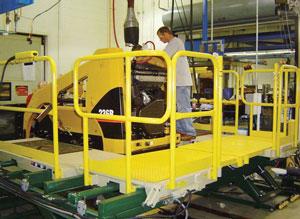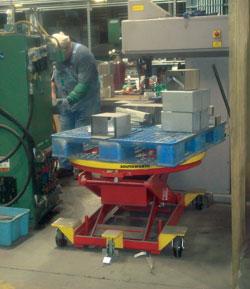- FMA
- The Fabricator
- FABTECH
- Canadian Metalworking
Hand off Manual Material Handling Risks
Automate for better ergonomics, fewer injuries, increased productivity, and leaner operations
- By Sue Roberts
- October 9, 2013
- Article
- Management

A lift table/turntable combination can properly position a large workpiece to avoid worker back strain.
A lean shop is an ergonomic shop. Or is it an ergonomic shop is a lean shop? Either way, lost-time injuries created by bad ergonomics violate the main tenant of lean operations. They waste time, human effort, and money.
“When you lose somebody to a back injury for six to eight months, the cost isn’t just the $80,000 that your insurance company pays out and the increase in insurance rates,” said Jim Galante, director of business development for Southworth Products Corp., Falmouth, Maine.
“You can identify and write a check for the direct costs, but some ergonomists quote indirect costs of an injury at as much as four times higher than direct expenses.” Indirect costs can include higher workers’ compensation rates, often for years; lost productivity; wasted motion; and errors, defects, and rejects that can occur because of an injury, or an inexperienced person replacing the injured employee—all forms of waste that work against a lean environment.
Lifting, Bending, Stretching
“Sixty percent of workers’ compensation cases are tied to manual material handling,” Galante said. “Nothing else comes close to those numbers.” Lifting, stretching, walking, and bending can put a worker at risk, so anything that can be done to minimize movement will benefit the company from the safety aspect while it improves productivity.
“Our workforce is in jeopardy. It is aging at an exponential rate. One out of three people in North America are overweight. About 85 percent of men will have back trouble, usually lower back, at some point in their lives. The back issues aren’t typically caused by a single event. They occur over time. A worker can pick up a casting that weighs only 4 pounds, but when he picks up hundreds or thousands of them from a pallet on the floor, it becomes an issue of accumulated trauma over a period of time.”
An Ergonomic Fix
Positioning is the key to improving ergonomics and protecting against injuries. Improve the fit between the demands of the work tasks and the capabilities of the workers. Position the work, people, pallets, and containers.
Positioning Work. Position large assemblies so workers have access to all parts without bending or reaching. A lift table coupled with a turntable can give the assembler the ability to raise or lower the workpiece to a comfortable height and rotate the assembly as needed. “Eliminate the use of step stools, walking, or crawling around. The assembler can stand firmly on the ground with the right physical attitude and get the work done more efficiently, more effectively, and more safely,” said Galante.
Reaching parts to be assembled in large electrical panels can require bending, leaning, and stretching. A lift and tilt table can position the panel vertically and change its ordination to reduce the assembler’s back strain while increasing efficiency and productivity.
Lifting large sheets of metal to feed a shear or press brake can require two employees to handle the weight and lift the material from a pallet on the floor. Galante suggests putting a lift table in front of the processing equipment. “Lift tables can allow one person rather than two to safely load a 4 - by 8-foot sheet. It’s the best of lean and ergonomics.”
Positioning People. Sometimes it is better to position people rather than work.

A three-sided personnel lift brings the worker to the work and provides him with safe mobility during assembly operations.
For assembling components on a tractor, a three-sided personnel lift with a traversing platform can wrap around the work to put the assembler in reach of various areas and allow him to move safely from one task to another. The platform can raise to give the worker access to the top of the vehicle to avoid back extension or stretching, and lower to eliminate the need to bend over while working on the wheel assemblies.
Positioning Pallets and Containers. “Arguably, 90 percent of pallets are loaded and unloaded by hand while they are sitting on the floor,” said Galante. “This is inefficient and wasteful, very bad ergonomics, and very bad lean. Our studies have shown that about 40 percent of loading time is spent walking around the pallet itself. If we can get a worker to maintain his location on the near side of the pallet being loaded or unloaded, we’ve increased his efficiency.” A turntable can rotate the pallet, saving the time and motion of walking around to remove or replace workpieces. A pallet positioner can raise and tilt a pallet so it doesn’t require bending for loading and unloading.
Loading and unloading containers also strains the back when a worker bends over to remove or pack a product. Container tilters adjust the height and angle of a container to put the products within comfortable reach without stretching or straining the lower back. Shops also can use leveling devices that fit into a container to raise the bottom, eliminating the need to reach down to retrieve or place materials.
“When we apply good ergonomics to make a job faster, easier, and safer, we eliminate wasted motion,” said Galante. “We gain the benefits of productivity, fewer injuries, and substantially contribute to lean operation goals.”
Photos courtesy of Southworth Products Corp.
Don’t Forget Office Ergonomics
“On any given day in North America, 240,000 salaried workers will not show up to work due to some sort of physical injury incurred at work,” said Ken Cowman, managing director at Emercomm Business Consultants, Milton, Ont. Most of that number comprises employees who work in an office, such as credit managers, master schedulers, and sales representatives.
As on the shop floor, an unsafe office environment can lead to temporary disability, chronic health problems, or remove a good employee from the workforce. A cable that is not taped down or an open file drawer can cause a trip, resulting in a multiple fracture that requires weeks to heal; repetitive motion can cause bursitis or tendinitis that may be alleviated when the movement is avoided but easily recurs once the action is resumed; an improperly placed computer screen can lead to neck strain that can trigger chronic migraines that disable a good employee.
“Costs are incurred, time is added, and human effort is wasted when workers are injured,” said Cowman. “Think about the impact on business when a CSR who has good relationships with key customers is not on the job. If you need to justify time or money invested in correcting unsafe office environments, quantify the results via value stream mapping.”
A safe environment increases employee job satisfaction and allows them to comfortably focus on the job without hazardous distractions. It safeguards their health while contributing to lean goals. When a worker is unable to perform a job, co-workers who may not be as adept or familiar with the task may have to absorb the work, stretching the time needed for completion, diluting focus on their own jobs, and adding stress. Or a new person may be brought in, which diverts productive time to training time.
“In lean manufacturing we used to talk about 5S [sort, set in order, shine, standardize, service]; the new term is 8S,” said Cowman. “Add safety, security, and satisfaction.”
subscribe now


Keep up to date with the latest news, events, and technology for all things metal from our pair of monthly magazines written specifically for Canadian manufacturers!
Start Your Free Subscription- Trending Articles
- Industry Events
MME Winnipeg
- April 30, 2024
- Winnipeg, ON Canada
CTMA Economic Uncertainty: Helping You Navigate Windsor Seminar
- April 30, 2024
- Windsor, ON Canada
CTMA Economic Uncertainty: Helping You Navigate Kitchener Seminar
- May 2, 2024
- Kitchener, ON Canada
Automate 2024
- May 6 - 9, 2024
- Chicago, IL
ANCA Open House
- May 7 - 8, 2024
- Wixom, MI















